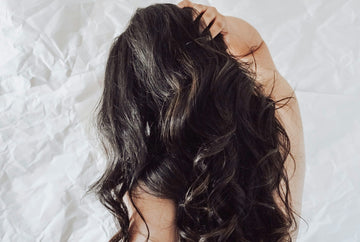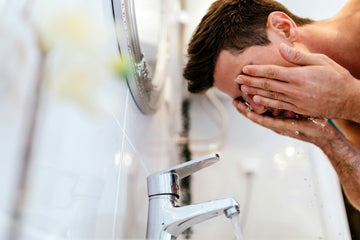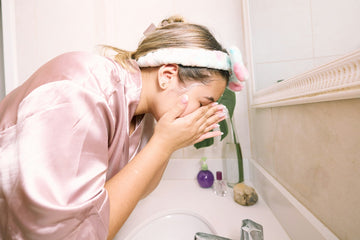Creating a skincare routine tailored to your specific skin type is essential for achieving a healthy, glowing skin barrier. Addressing dull skin through proper exfoliation and the use of serums containing antioxidants, like vitamin C, can significantly enhance the skin's appearance.
With so many products on the market, it can be overwhelming to know where to start. Whether your skin is dry, oily, combination, or sensitive, finding the right skincare products and techniques can make all the difference.
In this guide, we’ll walk you through the steps to build an effective skincare routine for your skin type, helping you to maintain balance and address specific concerns.

1. Identify Your Skin Type
Before diving into the world of skincare products, it’s crucial to understand your skin type. Identifying your skin type helps you choose the right products that target your skin’s unique needs. The four main skin types are:
-
Oily Skin: Characterized by excess sebum production, oily skin often appears shiny and may be prone to acne and enlarged pores. Products that help control oil and prevent breakouts are ideal for this skin type.
-
Dry Skin: This type lacks sufficient moisture and can feel tight, rough, or flaky. Hydrating products that provide deep moisture and nourishment are essential for dry skin.
-
Combination Skin: Combination skin features both oily and dry areas, typically with an oily T-zone (forehead, nose, and chin) and dry cheeks. Balancing products that address both concerns are best for this skin type.
-
Sensitive Skin: Sensitive skin is prone to redness, irritation, and reactions to certain ingredients. Gentle, hypoallergenic products are recommended to soothe and protect sensitive skin.
-
Normal Skin: Normal skin is well-balanced with even moisture, uniform texture, and small pores. It may occasionally experience mild dryness or oiliness. A normal skincare routine should adapt to these mild fluctuations while focusing on maintaining overall skin health and protection.
Dry Skin
Dry skin often feels tight, rough, or flaky, especially after washing. People with dry skin may notice dullness and uneven texture. This skin type lacks the necessary oils to keep it hydrated, which is why it’s prone to peeling and itching. It’s important to use nourishing and hydrating products to replenish the skin’s moisture barrier.
Oily Skin
Oily skin produces excess sebum, leading to a shiny appearance, especially in the T-zone (forehead, nose, chin). This skin type often struggles with enlarged pores, blackheads, and acne.
Oily skin requires products that control oil production without stripping the skin of its natural moisture.
Combination Skin
Combination skin is a mix of dry and oily areas, typically with an oily T-zone and dry cheeks. Managing combination skin can be tricky because different areas require different types of care. The key is to balance the skin’s oil production while keeping dry areas hydrated.
Sensitive Skin
Sensitive skin is easily irritated and prone to redness, dryness, and breakouts when exposed to certain ingredients or environmental factors. People with sensitive skin need gentle products that soothe irritation and maintain the skin’s natural barrier.
How to Identify Your Skin Type
A simple way to identify your skin type is by washing your face with a mild cleanser, patting it dry, and observing how it feels after 30 minutes.
If your skin feels tight or flaky, it’s likely dry. If it looks shiny, you probably have oily skin. If only your T-zone is shiny, you have combination skin. If your skin appears red or irritated after using a product, you may have sensitive skin.
If you're unsure, consult a dermatologist or use online tools like the guide from WebMD to help pinpoint your skin type.

2. Cleanse Gently
Cleansing is a fundamental step in any effective skincare routine, as it helps to remove dirt, oil, and makeup, leaving your skin fresh and clean.
Choosing the right cleanser for your skin type is essential to avoid stripping your skin of its natural oils or aggravating any existing skin issues.
Cleansers for Each Skin Type:
-
Dry Skin: Opt for a hydrating, non-foaming cleanser that helps replenish moisture while cleaning the skin. Creamy, milky cleansers are ideal for dry skin.
-
Oily Skin: Use a foaming or gel-based cleanser to control excess oil production and prevent clogged pores. Look for ingredients like salicylic acid that target oiliness and acne.
-
Combination Skin: A gentle, balanced cleanser works best to keep oily areas under control without drying out the skin.
-
Sensitive Skin: Look for a fragrance-free, hypoallergenic cleanser that won’t irritate or strip the skin. Products with soothing ingredients like aloe vera or chamomile are great choices.
Cleansing twice a day, in the morning and evening, ensures that your skin stays free from dirt, oil, and makeup that can lead to breakouts and dullness.
How to Wash Your Face Properly
Washing your face is the first step in any skincare routine, and it’s essential to do it correctly to remove dirt, oil, and impurities without stripping your skin of its natural moisture. Here’s how to wash your face properly:
-
Start with Lukewarm Water: Begin by wetting your face with lukewarm water. Hot water can strip your skin of its natural oils, while cold water may not effectively remove dirt and impurities.
-
Apply a Gentle Cleanser: Use a small amount of gentle cleanser, avoiding the delicate skin around your eyes. A gentle cleanser ensures that your skin is cleaned without being stripped of its essential moisture.
-
Massage in Circular Motions: Massage the cleanser into your skin using circular motions, working from the center of your face outwards. This helps to effectively remove dirt and oil.
-
Rinse Thoroughly: Rinse your face thoroughly with lukewarm water, making sure to remove all soap residue. Leftover cleanser can lead to irritation and clogged pores.
-
Pat Dry: Pat your face dry with a clean towel, rather than rubbing it vigorously. This helps to prevent irritation and keeps your skin soft and smooth.
By following these steps, you can ensure that your face is properly cleansed, setting the foundation for the rest of your skincare routine.

3. Tone Your Skin
Toning is an essential step in any skincare routine, and it can help to balance your skin’s pH, remove any remaining impurities, and prepare your skin for further products.
What is Toner and Its Benefits
A toner is a liquid product that is applied to the skin after cleansing to help balance the skin’s pH, remove any remaining impurities, and prepare the skin for further products.
Toners can be beneficial for all skin types, including oily skin, sensitive skin, and acne-prone skin.
Some of the benefits of using a toner include:
-
Balancing the Skin’s pH: Helps to restore the skin’s natural pH balance, which can be disrupted by cleansing.
-
Removing Remaining Impurities: Ensures that any leftover dirt, oil, or makeup is removed, leaving your skin clean and fresh.
-
Preparing the Skin for Further Products: Helps your skin to better absorb serums, moisturizers, and other treatments.
-
Reducing the Appearance of Pores: Can help to minimize the appearance of pores, giving your skin a smoother look.
-
Improving Skin Tone: Helps to even out your skin tone, making it look more radiant and healthy.
How to Use Toner in Your Routine
To use a toner in your routine, simply apply it to your face after cleansing, using a cotton pad or sweeping it across your face with your fingers. You can use a toner morning and night, or just at night if you prefer.
Some tips for using a toner include:
-
Choose the Right Toner: Use a toner that is suitable for your skin type. For example, if you have oily skin, look for a toner that helps control oil production.
-
Apply with a Cotton Pad: Apply the toner to a cotton pad and sweep it across your face, rather than applying it directly to your skin. This helps to ensure even application.
-
Avoid Harsh Ingredients: If you have sensitive skin, avoid toners that contain harsh ingredients like alcohol or witch hazel. Instead, opt for soothing ingredients like aloe vera or chamomile.
-
Use Consistently: Incorporate toner into your routine consistently, either morning and night or just at night, to see the best results.
By incorporating a toner into your skincare routine, you can help to improve the overall health and appearance of your skin, making it look more balanced and radiant.

3. Exfoliate Regularly
Exfoliation is key to maintaining smooth, radiant skin by removing dead skin cells and promoting cell turnover. However, the type and frequency of exfoliation depend on your skin type.
How to Exfoliate Based on Skin Type:
-
Dry Skin: Exfoliate once a week with a gentle scrub or chemical exfoliant containing lactic acid to avoid irritation while promoting smooth skin.
-
Oily Skin: Exfoliate 2-3 times a week using a product with salicylic acid to help remove excess oil and prevent clogged pores.
-
Combination Skin: Focus on exfoliating the oily areas more frequently while being gentle on the dry parts of your face.
-
Sensitive Skin: Use a mild exfoliant with soothing ingredients like oatmeal or enzymes once a week to avoid irritation.
Be cautious not to over-exfoliate, as this can cause more harm than good, especially for sensitive and dry skin types. Exfoliating at the right frequency ensures that your skin remains smooth and radiant without becoming irritated.
What is Exfoliation and Its Benefits
Exfoliation is the process of removing dead skin cells from the surface of the skin, and it can be beneficial for all skin types, including oily skin, sensitive skin, and acne-prone skin.

4. Hydrate with the Right Moisturizer
Hydration is crucial for all skin types, even oily skin. Moisturizers help lock in moisture and maintain the skin's barrier function, keeping it soft, supple, and protected from environmental stressors.
Moisturizers for Each Skin Type:
-
Dry Skin: Use a rich, emollient moisturizer packed with hydrating ingredients like hyaluronic acid and ceramides. These ingredients help lock in moisture and soothe dryness.
-
Oily Skin: A lightweight, oil-free moisturizer is best for oily skin to keep it hydrated without making it greasy. Look for non-comedogenic options that won’t clog pores.
-
Combination Skin: A gel-based or light cream moisturizer can keep dry areas hydrated without adding extra oil to the T-zone.
-
Sensitive Skin: Choose a gentle, fragrance-free moisturizer that contains calming ingredients like aloe vera, chamomile, or colloidal oatmeal to reduce redness and irritation.
Applying moisturizer twice daily helps keep your skin hydrated and protected from environmental stressors.
SELF offers a helpful guide on choosing the best moisturizer for your skin type, which can further assist you in finding the right product.

5. Protect with Sunscreen
Sunscreen is a must-have in every skincare routine, no matter your skin type. It protects your skin from harmful UV rays that can cause premature aging, hyperpigmentation, and even skin cancer. So if you are interested in making sure that your skin stays looking young and ageless, daily sunscreen is a must.
How to Choose the Right Sunscreen:
-
Look for a broad-spectrum sunscreen with an SPF of 30 or higher to protect against both UVA and UVB rays.
-
For oily skin, choose a lightweight, oil-free formula that won’t clog pores.
-
For dry or sensitive skin, opt for sunscreens with hydrating ingredients like hyaluronic acid or ceramides.
Applying sunscreen daily—even on cloudy days—is essential for preventing sun damage and maintaining youthful, healthy skin.
6. Address Specific Skin Concerns
Once you’ve established a solid skincare routine with cleansing, moisturizing, and sun protection, you can address any specific concerns you may have, such as acne, hyperpigmentation, or fine lines.
Targeted Treatments for Different Skin Types:
-
Dry Skin: Consider adding a hydrating serum with ingredients like hyaluronic acid or glycerin to boost moisture.
-
Oily Skin: Serums containing niacinamide or zinc can help control oil production and reduce the appearance of pores.
-
Combination Skin: Spot treatments are ideal for addressing breakouts in oily areas without drying out the rest of your face.
-
Sensitive Skin: Calming treatments with ingredients like aloe vera or chamomile can reduce redness and soothe irritation.
How to Build a Skincare Routine for Your Skin Type Conclusion
Building a consistent skincare routine tailored to your skin type is key to maintaining healthy, balanced, and glowing skin. By understanding your skin’s needs and selecting the right products, you can create a routine that keeps your skin healthy, balanced, and glowing.
Start by identifying your skin type, then cleanse, exfoliate, hydrate, and protect with sunscreen. Address any specific concerns with targeted treatments to ensure your skin looks its best every day.
Consistency is key—stick to your routine, and your skin will thank you!






